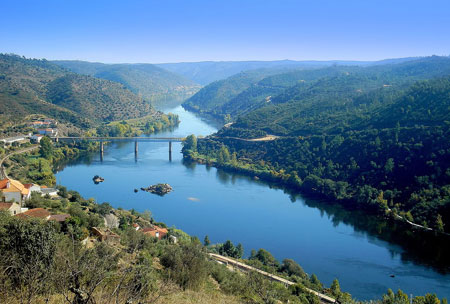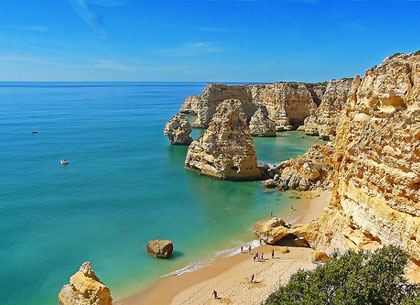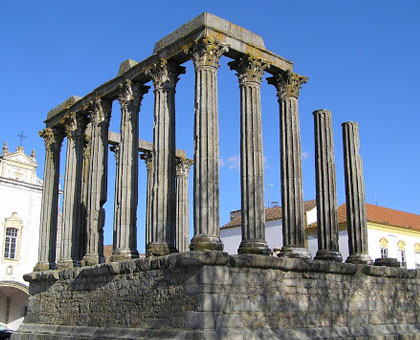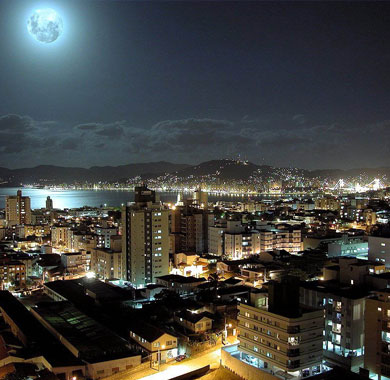Portugal
Country statistics

Land area: 35,382 sq miles (91,639 sq km)
Total area: 35,672 sq miles (92,391 sq km)
Population (2011 est.): 10,781,459 (growth rate: 0.18%); birth rate: 9.76/1000; infant mortality rate: 4.66/1000; life expectancy: 78.7
Capital City: Lisbon
Monetary unit: Euro (formerly escudo)
Languages: Portuguese (official), Mirandese (official, but locally used)
Ethnicity/race: homogeneous Mediterranean stock; less than 100,000 citizens of black African descent who immigrated to mainland during decolonization; East Europeans have entered since 1990
Religions: Religion Roman Catholic 84.5%, other Christian 2.2%, other 0.3%, unknown 9%, none 3.9% (2001 census)
Country introduction

Portugal is a country located in South-western Europe, on the Iberian Peninsula. It is the western-most country of mainland Europe, and is bordered by the Atlantic Ocean to the west and south and by Spain to the north and east. The territory also includes a series of archipelagoes in the Atlantic Ocean (the Azores and Madeira), which are strategic islands along western sea approaches to the Strait of Gibraltar and the Mediterranean Sea. The country is named after its second largest city, Porto, whose Latin name was Portus Cale.
The physical environment varies enormously, creating several distinct geographic regions that have shaped the culture of the people, their economy and society. Northern Portugal is a mountainous, rainy region, characterized by many small farms and vineyards. The Portuguese nation began in this region, fending off León and Castile while simultaneously driving the Moors south and eventually out of the peninsula. It is a desolate area of rocky hillsides where smallholders have survived on a meager existence for hundreds of years. This region is also said to be the origin of the strongest Portuguese national values of hard work, thrift, traditionalism, Roman Catholicism, and practicality. It is also an area, that has lost many of its inhabitants through emigration.
Central Portugal, include the Rio Douro and the longest river Rio Tejo (Tagus River). The central coastal region consists of dunes and pine forests, and many residents of the area earn their livelihood from fishing. The central eastern areas, known as the Beira, consist of mainly small and medium-sized farms, with some mining and light industry. The greater Lisbon area, including both the city and its suburbs, accounts for most of the nation's commerce and much of its industry.

Southern Portugal, known as the Alentejo (literally, "beyond the Tejo") is an area of gently rolling hills and plains dominated by extensive estates with large-scale agriculture and grazing. The extreme south of Portugal is known as the Algarve. It is a dry region of smallholdings, grazing, and fishing, and coastal towns. This is the area of Portugal most strongly influenced by the Moors and even today the Moorish influence is present in the region's dialect and architecture. With its warm climate and Mediterranean sky, the Algarve has also become a center for tourism and a home to many foreign retirees.
Two of Portugal's four sides are flanked by the Atlantic Ocean embellishing the country with 800 km (497 miles) of breathtaking coastline and lots of sandy Portugal beaches. Portugal's coastlines are so expansive that different climates are found in the different areas of the country.
The culture

Portuguese culture is based on a past that dates back to prehistoric times and has been heavily influenced by a rich variety of countries and customs over the years. The eras of the Roman and Moorish invasions as well as the ancient societies before have all left their traces in a rich legacy of archaeological remains that can be found throughout Portugal.
The ancient cave paintings at Escoural, the Roman township of Conímbriga, the Temple of Diana in Évora and the typical Moorish architecture of the southern towns Olhão and Tavira are just some examples of extraordinary cultural gems that can be found in the country.
Throughout the centuries, Portugal's arts have been enriched by foreign influences, including Flemish, French and Italian. The voyages of the Portuguese discoverers opened the country to Oriental inspiration and the revelation of Brazil's wealth of gold and jewels fed the Baroque flame in decoration.
Almost 95% of the population speak Portuguese. The Portugal literature has gone through rapid developments in the 12th century and the works of Paio Soares de Taveirós are an asset for the country.
The family is the integral part of the Portugal culture. Family is given more preference than the society or business. The Portuguese have a traditional and conservative mentality.
The people of Portugal love to dress fashionably. Appearance is a great factor for them. They try to wear the best apparels to build a good impression in the society. The Portugal people always show respect to their government. Officials of high rank are always respected. It is a custom to take flowers and gifts to attend invitations. Red flowers are not accepted in Portugal as it is assign of rebellion.
Fandango, Two Steps Waltz, Corridinho and Malhão are some of the great folk dances of the country.
Attractions & landmarks

The capital Lisbon is home to many of Portugal's most important landmarks and ancient treasures. Countless of ancient monuments are scattered all around the Lisbon region and few are more impressive than the Castle of São Jorge, which stands proudly atop the highest hill in Lisbon city centre, quite literally dominating the area from its elevated position. Alfama is the oldest district of Lisbon which is set on the side of a steep incline with the impressive St. George's Church as its pinnacle. Other landmarks in Lisbon include The Pena National Palace, which is located in the small town of Sintra. Built in the 19th century from the ruins of an ancient monastery it exemplifies Roman revivalism. Belém Tower is a significant landmark and is a beautiful sight to see. It was built in 1520 as a protective fortress and still lies on the banks of the Tagus River.
Because Portugal is perched on the coast and steeped in a rich and diverse marine history, many of Lisbon's attractions are of the aquatic variety. Visitors can check out the Lisbon Oceanarium, the largest indoor Aquarium in Europe. It houses a wonderful array of marine species, birds, mammals, fish, cnidaria, and other marine organisms totaling about 16,000 individuals of 450 species. For a slightly more historical look at the sea, the Maritime Museum is one of Europe's best and a must for history buffs.
The beaches in Portugal covers around 600 miles of the coast and are among the best in the world. The most popular is the Algarve which has a string of beautiful, clean, sandy beaches. These vary from secluded coves with amazing cliffs to vast stretches of golden sand, all sea washed by the fresh and clear Atlantic Ocean. Inland there are many quaint villages to be found that have barely been touched by tourism. The small fishing villages, such as Santa Luzia in Tavira, and the small port of Sagres are idyllic and peaceful. The Algarve has 30 golf courses and are some of the best in Europe.